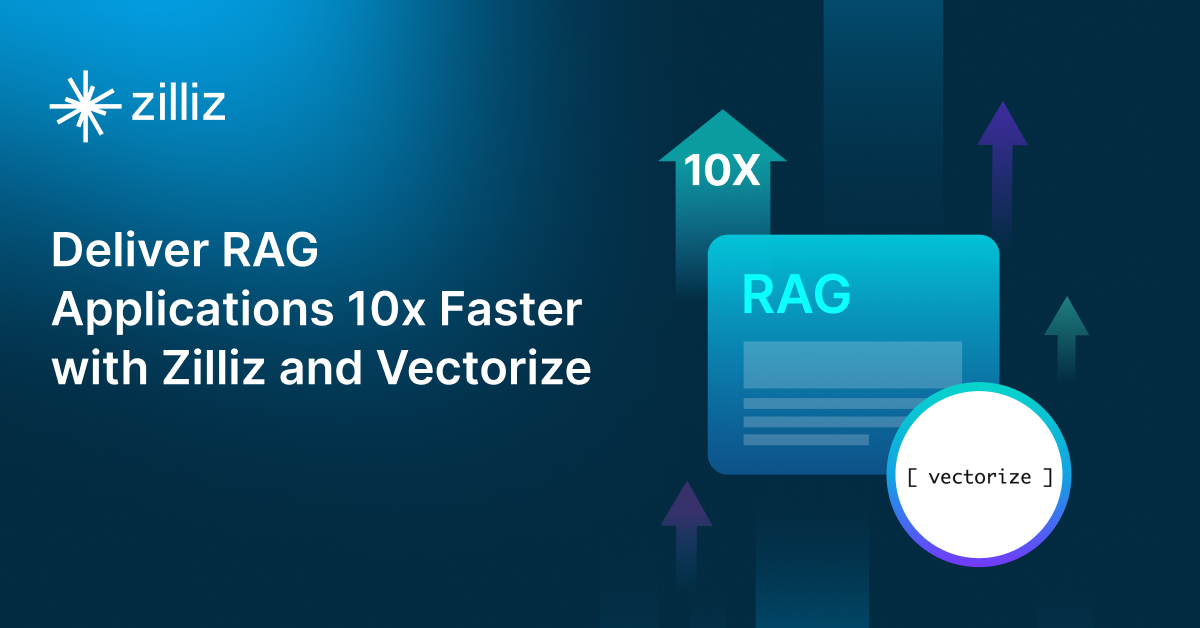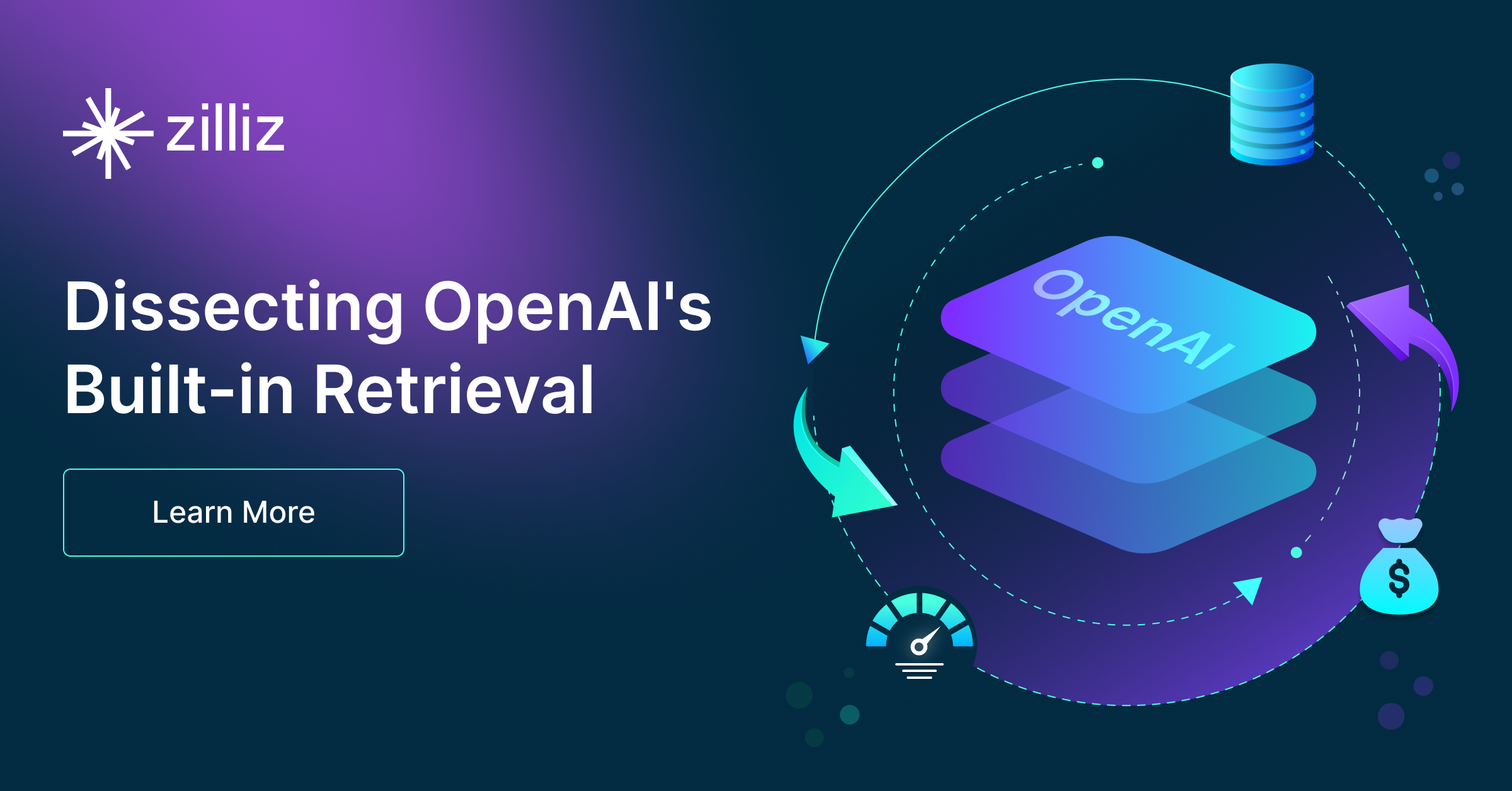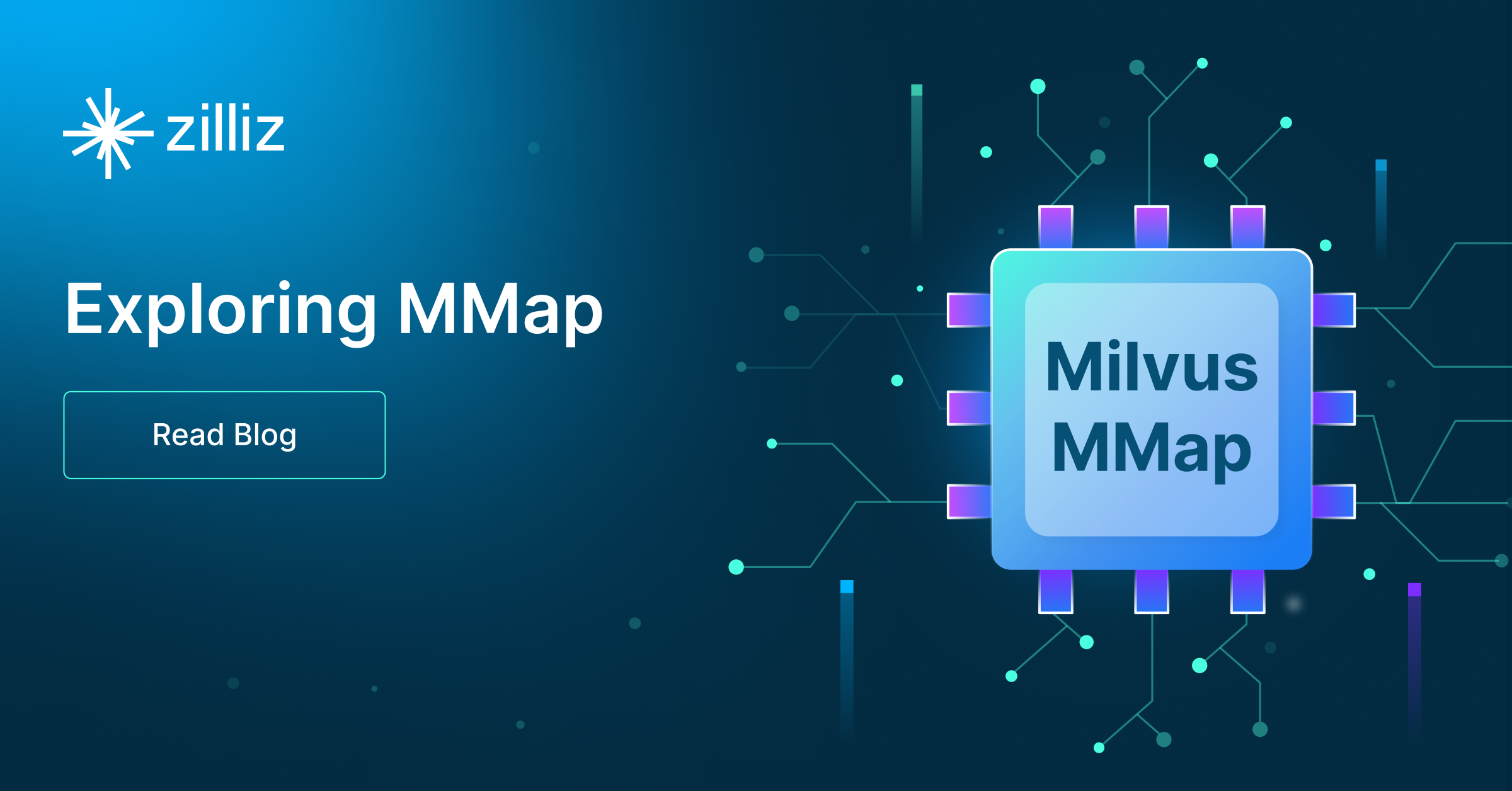Build RAG Chatbot with LangChain, LangChain vector store, Google Vertex AI Gemini 1.5 Pro, and Cohere embed-english-v3.0
Introduction to RAG
Retrieval-Augmented Generation (RAG) is a game-changer for GenAI applications, especially in conversational AI. It combines the power of pre-trained large language models (LLMs) like OpenAI’s GPT with external knowledge sources stored in vector databases such as Milvus and Zilliz Cloud, allowing for more accurate, contextually relevant, and up-to-date response generation. A RAG pipeline usually consists of four basic components: a vector database, an embedding model, an LLM, and a framework.
Key Components We'll Use for This RAG Chatbot
This tutorial shows you how to build a simple RAG chatbot in Python using the following components:
- LangChain: An open-source framework that helps you orchestrate the interaction between LLMs, vector stores, embedding models, etc, making it easier to integrate a RAG pipeline.
- LangChain in-memory vector store: an in-memory, ephemeral vector store that stores embeddings in-memory and does an exact, linear search for the most similar embeddings. The default similarity metric is cosine similarity, but can be changed to any of the similarity metrics supported by ml-distance. It is intended for demos and does not yet support ids or deletion. (If you want a much more scalable solution for your apps or even enterprise projects, we recommend using Zilliz Cloud, which is a fully managed vector database service built on the open-source Milvusand offers a free tier supporting up to 1 million vectors.)
- Google Vertex AI Gemini 1.5 Pro: This advanced AI model combines powerful machine learning capabilities with enhanced multimodal support, enabling seamless processing of text, images, and audio. Its strengths lie in scalability and customization, making it ideal for enterprise applications such as content generation, data analysis, and customer interaction automation.
- Cohere embed-english-v3.0: This model specializes in generating high-quality text embeddings for English language input. It is designed for tasks like semantic search, recommendation systems, and document similarity, providing robust performance due to its deep contextual understanding. Ideal for applications needing nuanced language comprehension and efficient information retrieval.
By the end of this tutorial, you’ll have a functional chatbot capable of answering questions based on a custom knowledge base.
Note: Since we may use proprietary models in our tutorials, make sure you have the required API key beforehand.
Step 1: Install and Set Up LangChain
%pip install --quiet --upgrade langchain-text-splitters langchain-community langgraph
Step 2: Install and Set Up Google Vertex AI Gemini 1.5 Pro
pip install -qU "langchain[google-vertexai]"
# Ensure your VertexAI credentials are configured
from langchain.chat_models import init_chat_model
llm = init_chat_model("gemini-1.5-pro", model_provider="google_vertexai")
Step 3: Install and Set Up Cohere embed-english-v3.0
pip install -qU langchain-cohere
import getpass
import os
if not os.environ.get("COHERE_API_KEY"):
os.environ["COHERE_API_KEY"] = getpass.getpass("Enter API key for Cohere: ")
from langchain_cohere import CohereEmbeddings
embeddings = CohereEmbeddings(model="embed-english-v3.0")
Step 4: Install and Set Up LangChain vector store
pip install -qU langchain-core
from langchain_core.vectorstores import InMemoryVectorStore
vector_store = InMemoryVectorStore(embeddings)
Step 5: Build a RAG Chatbot
Now that you’ve set up all components, let’s start to build a simple chatbot. We’ll use the Milvus introduction doc as a private knowledge base. You can replace it with your own dataset to customize your RAG chatbot.
import bs4
from langchain import hub
from langchain_community.document_loaders import WebBaseLoader
from langchain_core.documents import Document
from langchain_text_splitters import RecursiveCharacterTextSplitter
from langgraph.graph import START, StateGraph
from typing_extensions import List, TypedDict
# Load and chunk contents of the blog
loader = WebBaseLoader(
web_paths=("https://milvus.io/docs/overview.md",),
bs_kwargs=dict(
parse_only=bs4.SoupStrainer(
class_=("doc-style doc-post-content")
)
),
)
docs = loader.load()
text_splitter = RecursiveCharacterTextSplitter(chunk_size=1000, chunk_overlap=200)
all_splits = text_splitter.split_documents(docs)
# Index chunks
_ = vector_store.add_documents(documents=all_splits)
# Define prompt for question-answering
prompt = hub.pull("rlm/rag-prompt")
# Define state for application
class State(TypedDict):
question: str
context: List[Document]
answer: str
# Define application steps
def retrieve(state: State):
retrieved_docs = vector_store.similarity_search(state["question"])
return {"context": retrieved_docs}
def generate(state: State):
docs_content = "\n\n".join(doc.page_content for doc in state["context"])
messages = prompt.invoke({"question": state["question"], "context": docs_content})
response = llm.invoke(messages)
return {"answer": response.content}
# Compile application and test
graph_builder = StateGraph(State).add_sequence([retrieve, generate])
graph_builder.add_edge(START, "retrieve")
graph = graph_builder.compile()
Test the Chatbot
Yeah! You've built your own chatbot. Let's ask the chatbot a question.
response = graph.invoke({"question": "What data types does Milvus support?"})
print(response["answer"])
Example Output
Milvus supports various data types including sparse vectors, binary vectors, JSON, and arrays. Additionally, it handles common numerical and character types, making it versatile for different data modeling needs. This allows users to manage unstructured or multi-modal data efficiently.
Optimization Tips
As you build your RAG system, optimization is key to ensuring peak performance and efficiency. While setting up the components is an essential first step, fine-tuning each one will help you create a solution that works even better and scales seamlessly. In this section, we’ll share some practical tips for optimizing all these components, giving you the edge to build smarter, faster, and more responsive RAG applications.
LangChain optimization tips
To optimize LangChain, focus on minimizing redundant operations in your workflow by structuring your chains and agents efficiently. Use caching to avoid repeated computations, speeding up your system, and experiment with modular design to ensure that components like models or databases can be easily swapped out. This will provide both flexibility and efficiency, allowing you to quickly scale your system without unnecessary delays or complications.
LangChain in-memory vector store optimization tips
LangChain in-memory vector store is just an ephemeral vector store that stores embeddings in-memory and does an exact, linear search for the most similar embeddings. It has very limited features and is only intended for demos. If you plan to build a functional or even production-level solution, we recommend using Zilliz Cloud, which is a fully managed vector database service built on the open-source Milvus and offers a free tier supporting up to 1 million vectors.)
Google Vertex AI Gemini 1.5 Pro optimization tips
Gemini 1.5 Pro is a robust model designed for complex RAG applications requiring deep reasoning. Optimize retrieval by implementing advanced ranking algorithms to ensure highly relevant documents are included. Structure prompts with clear logical sections to maximize response coherence. Keep temperature between 0.1 and 0.3 for factual precision, fine-tuning top-k/top-p as needed. Use Google’s AI infrastructure to batch API calls, reducing processing overhead. Implement caching strategies to optimize frequently queried topics. Streaming responses can enhance real-time applications, improving perceived responsiveness. If deploying multiple models, reserve Gemini 1.5 Pro for high-value analytical tasks while using lighter models for simpler retrieval-based queries.
Cohere embed-english-v3.0 optimization tips
Cohere embed-english-v3.0 is a robust embedding model tailored for English language text. To optimize retrieval, preprocess input text to eliminate irrelevant noise and focus on key terms or phrases that will drive relevant matches. Use approximate nearest neighbor (ANN) algorithms like HNSW for efficient retrieval in large-scale datasets. For resource management, employ dimensionality reduction or quantization techniques to compress embeddings, reducing storage requirements without sacrificing too much performance. Implement multi-threading for batch processing to accelerate embedding generation. Use caching to store frequently accessed embeddings and reduce redundant computations. Fine-tune the model on specific data to improve performance on domain-specific queries and ensure greater relevance in retrieval.
By implementing these tips across your components, you'll be able to enhance the performance and functionality of your RAG system, ensuring it’s optimized for both speed and accuracy. Keep testing, iterating, and refining your setup to stay ahead in the ever-evolving world of AI development.
RAG Cost Calculator: A Free Tool to Calculate Your Cost in Seconds
Estimating the cost of a Retrieval-Augmented Generation (RAG) pipeline involves analyzing expenses across vector storage, compute resources, and API usage. Key cost drivers include vector database queries, embedding generation, and LLM inference.
RAG Cost Calculator is a free tool that quickly estimates the cost of building a RAG pipeline, including chunking, embedding, vector storage/search, and LLM generation. It also helps you identify cost-saving opportunities and achieve up to 10x cost reduction on vector databases with the serverless option.
 Calculate your RAG cost
Calculate your RAG cost
What Have You Learned?
What a journey you've traveled through this tutorial! You have navigated the exciting world of building a cutting-edge retrieval-augmented generation (RAG) system, and it's time to celebrate your progress! By integrating a robust framework like LangChain with a powerful vector database, such as the LangChain vector store, you've created a solid backbone for your RAG application. This framework elegantly ties all components together, ensuring smooth workflows and efficient data handling.
Your vector database has opened up the gateway to lightning-fast searches, allowing you to retrieve relevant data in a heartbeat. You've seen how crucial it is for maximizing the efficiency of your application. Plus, with the integration of a large language model like Google Vertex AI Gemini 1.5 Pro, you've supercharged your system with extraordinary conversational intelligence, making interactions with users not only seamless but also rich and engaging.
The embedding model, specifically Cohere embed-english-v3.0, has empowered you to create sophisticated semantic representations, enabling your system to understand and process information in truly remarkable ways. We even touched on optimization tips and employed a free cost calculator to tailor your application to your needs, reducing overhead while maximizing performance.
Now, the possibilities are endless! With your newfound skills and understanding, you're ready to build, optimize, and innovate your own RAG applications. So roll up your sleeves, dive back in, and bring your creative ideas to life. The world of AI is eager for your contributions, and who knows? Your next project could change the game! Get started today!
Further Resources
🌟 In addition to this RAG tutorial, unleash your full potential with these incredible resources to level up your RAG skills.
- How to Build a Multimodal RAG | Documentation
- How to Enhance the Performance of Your RAG Pipeline
- Graph RAG with Milvus | Documentation
- How to Evaluate RAG Applications - Zilliz Learn
- Generative AI Resource Hub | Zilliz
We'd Love to Hear What You Think!
We’d love to hear your thoughts! 🌟 Leave your questions or comments below or join our vibrant Milvus Discord community to share your experiences, ask questions, or connect with thousands of AI enthusiasts. Your journey matters to us!
If you like this tutorial, show your support by giving our Milvus GitHub repo a star ⭐—it means the world to us and inspires us to keep creating! 💖
- Introduction to RAG
- Key Components We'll Use for This RAG Chatbot
- Step 1: Install and Set Up LangChain
- Step 2: Install and Set Up Google Vertex AI Gemini 1.5 Pro
- Step 3: Install and Set Up Cohere embed-english-v3.0
- Step 4: Install and Set Up LangChain vector store
- Step 5: Build a RAG Chatbot
- Optimization Tips
- RAG Cost Calculator: A Free Tool to Calculate Your Cost in Seconds
- What Have You Learned?
- Further Resources
- We'd Love to Hear What You Think!
Content
Vector Database at Scale
Zilliz Cloud is a fully-managed vector database built for scale, perfect for your RAG apps.
Try Zilliz Cloud for Free


